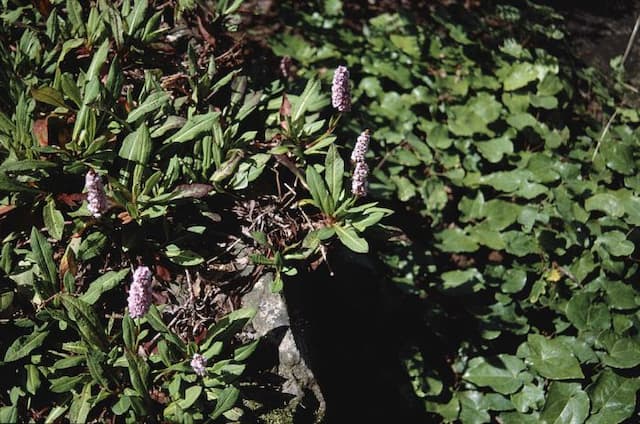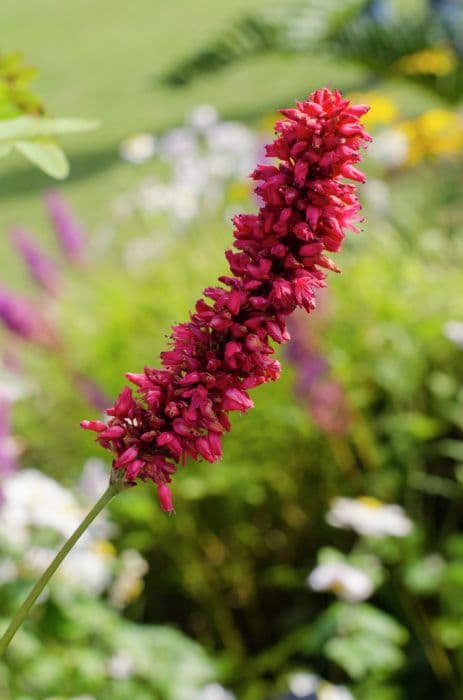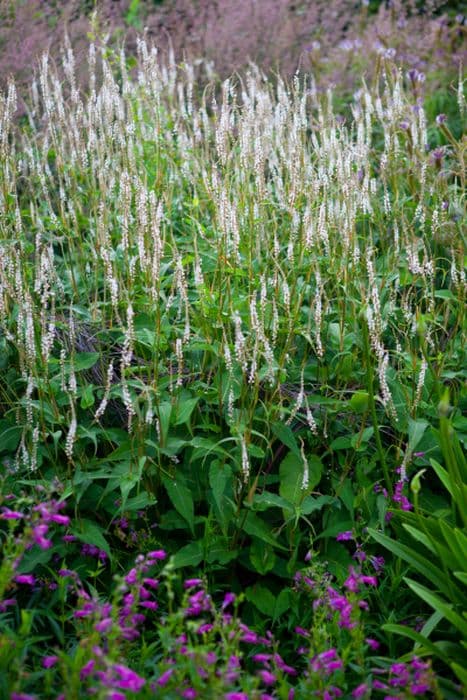Dwarf smartweed Persicaria affinis 'Superba'

ABOUT
Persicaria affinis 'Superba', also known as Himalayan fleece flower, is a perennial ground cover noted for its dense mats of lance-shaped, deep green leaves. Throughout the seasons, the foliage shows off an interesting range of colors: The leaves can take on hues of bronze and crimson, especially in the cooler months, adding to the ornamental value of the plant. Adding to its charm, the Himalayan fleece flower produces a profusion of small, tightly-packed, bottlebrush-like spikes of flowers that bloom atop short stems. The flowers typically open in shades of pale pink and deepen to a rich rosy-red as they mature, creating a lovely two-tone effect that stands out in any landscape setting. The bloom period lasts from mid-summer into fall, providing a long season of visual interest. The overall appearance of the Himalayan fleece flower is one of a lush, carpeting plant with vibrant, seasonally changing foliage and eye-catching floral displays that can add texture and color to gardens.
About this plant
 Names
NamesFamily
Polygonaceae.
Synonyms
Himalayan Bistort, Fleeceflower, Knotweed.
Common names
Persicaria affinis, Polygonum affine, Bistorta affinis, Polygonum brunonis.
 Toxicity
ToxicityTo humans
The plant known as Himalayan bistort is not listed as toxic to humans. However, it is always advisable to exercise caution and avoid ingesting plants that are not commonly recognized as food, as individual sensitivity can vary.
To pets
Himalayan bistort is not commonly known to be toxic to pets. However, as with humans, pets can sometimes have sensitivities or allergies to certain plants. It is always best to prevent pets from consuming non-food plants and monitor them for any signs of distress.
 Characteristics
CharacteristicsLife cycle
Perennials
Foliage type
Evergreen
Color of leaves
Green
Flower color
Pink
Height
1 foot (30 cm)
Spread
2 feet (60 cm)
Plant type
Herb
Hardiness zones
4
Native area
Himalayas
Benefits
 General Benefits
General Benefits- Easy Care: Persicaria affinis 'Superba', commonly known as Dwarf Smartweed, is a low-maintenance plant that is easy to grow and care for, making it suitable for gardeners of all skill levels.
- Ground Cover: It acts as an effective ground cover, spreading to fill spaces and suppress weeds, thereby reducing the need for mulching and weeding.
- Drought Tolerance: Once established, Dwarf Smartweed exhibits good drought tolerance, requiring less frequent watering than many other garden plants.
- Erosion Control: Its dense growth and spreading habit help to stabilize soil on slopes, making it an excellent choice for erosion control in challenging garden areas.
- Long Blooming Period: Dwarf Smartweed offers a long blooming period from midsummer into autumn, providing extended color and interest in the garden.
- Attracts Pollinators: The flowers of the plant are attractive to bees and butterflies, promoting pollinator activity in the garden which is beneficial for biodiversity.
- Adaptability: It can adapt to a range of soil types, from clay to loam, and can tolerate different soil pH levels, from slightly acidic to alkaline.
 Medical Properties
Medical PropertiesThis plant is not used for medical purposes.
 Air-purifying Qualities
Air-purifying QualitiesThis plant is not specifically known for air purifying qualities.
 Other Uses
Other Uses- Persicaria affinis 'Superba', commonly known as knotweed, can be used as a natural dye for fabrics, offering a range of colors depending on the mordant used in the dyeing process.
- Knotweed, when dried and pressed, can be used for botanical illustration practice or as artistic material in herbarium collections and nature-inspired art pieces.
- The dense mat-forming nature of the plant can serve as a protective cover for smaller wildlife, offering a microhabitat for insects and small animals.
- Its fibrous stems and leaves can be woven into small handicrafts like baskets or decorative objects by creative gardeners and crafters.
- Knotweed can be used in educational settings for plant identification and horticulture training because of its distinctive features and growth habits.
- During autumn, the plant's changing foliage provides an excellent opportunity for photographers to capture the beauty of seasonal garden changes.
- It can be used in sensory gardens due to its varied texture; from the soft, lush greenery of spring to the firmer, bronzed foliage of fall.
- As an attractive ground cover, knotweed can be used in designing living logos or green signage when planted in certain patterns.
- The plant's ability to thrive on slopes and embankments makes it a good candidate for soil erosion control in landscape projects.
- Young, creative minds can utilize knotweed's various stages of growth in nature-based learning activities, such as observing life cycles and eco-system interactions.
Interesting Facts
 Feng Shui
Feng ShuiThe Knotweed is not used in Feng Shui practice.
 Zodiac Sign Compitability
Zodiac Sign CompitabilityThe Knotweed is not used in astrology practice.
 Plant Symbolism
Plant Symbolism- Unity - Persicaria affinis 'Superba', commonly known as knotweed, often symbolizes unity because of its mat-forming habit, where interconnected stems and rhizomes create a tight-knit carpet, representing the interconnectedness of individuals in a community.
- Resilience - Knotweed is a hardy plant, thriving in a variety of conditions and demonstrating an ability to adapt and survive, echoing the human quality of resilience through tough circumstances.
- Abundance - The vigorous growth and abundant pink flower spikes of knotweed can symbolize abundance and prosperity, reflecting the plant’s prolific nature.
- Perseverance - With its ability to spread and cover ground quickly, knotweed signifies perseverance and the determination to grow and prosper, even in challenging environments.
 Water
WaterThe carpeting smartweed, or Persicaria affinis 'Superba', prefers consistent moisture with a well-draining soil. Watering should take place once a week with approximately 1 gallon of water per plant to ensure the soil stays moist but not waterlogged. During hot and dry spells, you may need to water twice a week, whereas during cooler or rainy periods, watering frequency should be reduced. Pay attention to the soil moisture level; if the top inch of soil is dry, it's a good indication that the plant needs water.
 Light
LightCarpeting smartweed thrives best in full sun to partial shade. It can tolerate a wide range of light conditions, but optimal growth is achieved with at least 4 to 6 hours of sunlight each day. Avoid deep shade as it can lead to leggy growth and fewer flowers.
 Temperature
TemperatureCarpeting smartweed is hardy and adapts to a moderate range, with ideal growing temperatures between 60°F and 75°F. It can tolerate minimum temperatures down to about -20°F and maximum temperatures up to around 85°F, making it a versatile choice for various climate zones.
 Pruning
PruningCarpeting smartweed benefits from occasional pruning to maintain its shape and encourage denser growth. The best time for pruning is in the spring to remove any dead or damaged foliage from over the winter. Pruning can be done as needed throughout the growing season to remove spent flower spikes and encourage additional blooming.
 Cleaning
CleaningAs needed
 Soil
SoilThe best soil mix for Knotweed (Persicaria affinis 'Superba') is a well-draining, loamy soil enriched with organic matter. The soil pH should ideally be neutral to slightly acidic, ranging from 6.0 to 7.0 to support healthy growth.
 Repotting
RepottingKnotweed does not typically require frequent repotting as it is a hardy ground cover; repotting can be done every 2-3 years or when you see signs of overcrowding and reduced growth.
 Humidity & Misting
Humidity & MistingKnotweed is adaptable and does not require specific humidity levels; it thrives in average garden conditions without the need for additional humidity control.
 Suitable locations
Suitable locationsIndoor
Place in bright, indirect light with moist soil.
Outdoor
Plant in sun to part shade, and water regularly.
Hardiness zone
4-9 USDA
 Life cycle
Life cycleThe Himalayan Bistort or Persicaria affinis 'Superba' begins its life cycle with seed germination, once the conditions become favorable in spring, usually requiring moist, well-drained soil and partial to full sunlight. The plant then develops a rosette of leaves from which stems grow, leading to vegetative growth; it is known for its mat-forming ability, spreading quickly through stolons. For the Himalayan Bistort, the flowering stage typically occurs in late spring to late summer, presenting dense spikes of small pink flowers that gradually deepen to red as they mature. After pollination, often by insects, the flowers produce seeds that are dispersed by various means, including water or animals, to start new plants elsewhere. The plant is perennial, so after the flowering stage, it will enter a period of dormancy during colder months, dying back to the ground level before resuming growth from its root system when the next growing season begins. Over time, the clumps formed by this species can be divided in the spring or autumn to manage its spread and to propagate new plants.
 Propogation
PropogationPropogation time
Spring-Early Summer
Persicaria affinis 'Superba', commonly known as Dwarf smartweed or Himalayan bistort, can be propagated through division, which is the most popular method for this plant. The best time to propagate through division is in the spring when the plant is emerging from dormancy or in the fall after the blooming period has ended. To propagate by division, carefully lift the clump from the ground using a garden fork, ensuring you do not damage the root system. Then, using your hands or a sharp knife, divide the clump into smaller sections, each with a good amount of roots and several shoots. Replant these divisions at the same depth they were originally growing, spacing them about 12 to 15 inches (about 30 to 38 centimeters) apart to allow for growth. Water the new divisions well to help establish them. This simple process can rejuvenate older plants and rapidly increase the number of Dwarf smartweeds in your garden.





![Red bistort [Taurus]](/_next/image?url=https%3A%2F%2Fplants-admin.emdemapps.com%2Fimages%2Fplants%2F%2Fimages%2F604b548be7841.png&w=640&q=75)



